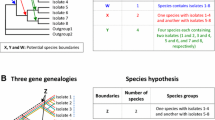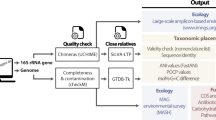Abstract
DNA–DNA hybridizations (DDH) play a key role in microbial species discrimination in cases when 16S rRNA gene sequence similarities are 97 % or higher. Using real-world 16S rRNA gene sequences and DDH data, we here re-investigate whether or not, and in which situations, this threshold value might be too conservative. Statistical estimates of these thresholds are calculated in general as well as more specifically for a number of phyla that are frequently subjected to DDH. Among several methods to infer 16S gene sequence similarities investigated, most of those routinely applied by taxonomists appear well suited for the task. The effects of using distinct DDH methods also seem to be insignificant. Depending on the investigated taxonomic group, a threshold between 98.2 and 99.0 % appears reasonable. In that way, up to half of the currently conducted DDH experiments could safely be omitted without a significant risk for wrongly differentiated species.

Similar content being viewed by others
References
Akaike H (1974) A new look at the statistical model identification. IEEE Trans Automat Contr 19:716–723. doi:10.1109/TAC.1974.1100705
Altschul S, Gish W, Miller W et al (1990) Basic local alignment search tool. J Mol Biol 215:403–410
Auch A, Von Jan M, Klenk H-P, Göker M (2010a) Digital DNA–DNA hybridization for microbial species delineation by means of genome-to-genome sequence comparison. Stand Genomic Sci 2:117–134. doi:10.4056/sigs.531120
Auch A, Klenk H-P, Göker M (2010b) Standard operating procedure for calculating genome-to-genome distances based on high-scoring segment pairs. Stand Genomic Sci 2:142–148. doi:10.4056/sigs.541628
Crawley MJ (2007) The R book. Wiley, Chichester
Cui H-L, Zhou P-J, Oren A, Liu S-J (2009) Intraspecific polymorphism of 16S rRNA genes in two halophilic archaeal genera, Haloarcula and Halomicrobium. Extremophiles 13:31–37. doi:10.1007/s00792-008-0194-2
De Ley J, Cattoir H, Reynaerts A (1970) The quantitative measurement of DNA hybridization from renaturation rates. Eur J Biochem 12:133–142. doi:10.1111/j.1432-1033.1970.tb00830.x
Euzéby JP (1997) List of bacterial names with standing in nomenclature: a folder available on the internet. Int J Syst Bacteriol 47:590–592. doi:10.1099/00207713-47-2-590
Ezaki T, Hashimoto Y, Yabuuchi E (1989) Fluorometric deoxyribonucleic acid-deoxyribonucleic acid hybridization in microdilution wells as an alternative to membrane filter hybridization in which radioisotopes are used to determine genetic relatedness among bacterial strains. Int J Syst Bacteriol 39:224–229. doi:10.1099/00207713-39-3-224
Felsenstein J (2004) Inferring phylogenies. Sinauer Associates, Sunderland
Goris J, Konstantinidis K, Klappenbach J et al (2007) DNA–DNA hybridization values and their relationship to whole-genome sequence similarities. Int J Syst Evol Microbiol 57:81–91. doi:10.1099/ijs.0.64483-0
Harrell FE, Lee KL, Califf RM et al (1984) Regression modelling strategies for improved prognostic prediction. Stat Med 3:143–152. doi:10.1002/sim.4780030207
Hasegawa M, Kishino H, Yano T (1985) Dating of the human-ape splitting by a molecular clock of mitochondrial DNA. J Mol Evol 22:160–174
Henz SR, Huson DH, Auch AF et al (2005) Whole-genome prokaryotic phylogeny. Bioinformatics 21:2329–2335. doi:10.1093/bioinformatics/bth324
Jukes T, Cantor C (1969) Evolution of protein molecules. Academic Press, New York
Keswani J, Whitman WB (2001) Relationship of 16S rRNA sequence similarity to DNA hybridization in prokaryotes. Int J Syst Evol Microbiol 51:667–678
Kimura M (1980) A simple method for estimating evolutionary rates of base substitutions through comparative studies of nucleotide sequences. J Mol Evol 16:111–120
Klenk H-P, Göker M (2010) En route to a genome-based classification of Archaea and Bacteria? Syst Appl Microbiol 33:175–182. doi:10.1016/j.syapm.2010.03.003
Konstantinidis KT, Tiedje JM (2005) Genomic insights that advance the species definition for prokaryotes. Proc Natl Acad Sci USA 102:2567–2572
Konstantinidis KT, Tiedje JM (2007) Prokaryotic taxonomy and phylogeny in the genomic era: advancements and challenges ahead. Curr Opin Microbiol 10:504–509. doi:10.1016/j.mib.2007.08.006
Kostinek M, Pukall R, Rooney AP et al (2005) Lactobacillus arizonensis is a later heterotypic synonym of Lactobacillus plantarum. Int J Syst Evol Microbiol 55:2485–2489. doi:10.1099/ijs.0.63880-0
Lagier J-C, Karkouri K El, Rivet R et al (2013) Non contiguous-finished genome sequence and description of Senegalemassilia anaerobia gen. nov., sp. nov. Stand Genomic Sci. doi: 10.4056/sigs.3246665
Meier-Kolthoff JP, Auch AF, Klenk H-P, Göker M (2013) Genome sequence-based species delimitation with confidence intervals and improved distance functions. BMC Bioinformatics 14:60. doi:10.1186/1471-2105-14-60
Motulsky H, Christopoulos A (2004) Fitting models to biological data using linear and nonlinear regression: a practical guide to curve fitting. Oxford University Press, Oxford
Nelder JA, Wedderburn RWM (1972) Generalized linear models. J R Stat Soc 135:370–384
Peduzzi P, Concato J, Kemper E et al (1996) A simulation study of the number of events per variable in logistic regression analysis. J Clin Epidemiol 49:1373–1379
Rice P, Longden I, Bleasby A (2000) EMBOSS: the European Molecular Biology Open Software Suite. Trends Genet 16:276–277
Richter M, Rosselló-Móra R (2009) Shifting the genomic gold standard for the prokaryotic species definition. Proc Natl Acad Sci USA 106:19126–19131. doi:10.1073/pnas.0906412106
Stackebrandt E, Ebers J (2006) Taxonomic parameters revisited: tarnished gold standards. Microbiol Today 33:152–155
Stackebrandt E, Goebel BM (1994) Taxonomic note: a place for DNA–DNA reassociation and 16S rRNA sequence analysis in the present species definition in bacteriology. Int J Syst Bacteriol 44:846–849. doi:10.1099/00207713-44-4-846
Steyerberg EW, Eijkemans MJC, Harrell FE, Habbema JDF (2000) Prognostic modelling with logistic regression analysis: a comparison of selection and estimation methods in small data sets. Stat Med 19:1059–1079
Stone M (1974) Cross-validatory choice and assessment of statistical predictions. J R Stat Soc 36:111–147. doi:10.2307/2984809
Swezey JL, Nakamura LK, Abbott TP, Peterson RE (2000) Lactobacillus arizonensis sp. nov., isolated from jojoba meal. Int J Syst Evol Microbiol 50:1803–1809. doi:10.1099/00207713-50-5-1803
Swofford DL (2003) PAUP*. Phylogenetic analysis using parsimony (*and other methods). Version 4. Sinauer Associates, Sunderland
R Development Core Team (2011) R: a language and environment for statistical computing. R Foundation for Statistical Computing, Vienna, Austria. http://r-project.org/
Tindall BJ, Kampfer P, Euzeby JP, Oren A (2006) Valid publication of names of prokaryotes according to the rules of nomenclature: past history and current practice. Int J Syst Evol Microbiol 56:2715–2720. doi:10.1099/ijs.0.64780-0
Tindall B, Rosselló-Móra R, Busse HJ et al (2010) Notes on the characterization of prokaryote strains for taxonomic purposes. Int J Syst Evol Microbiol 60:249–266. doi:10.1099/ijs.0.016949-0
Tourova TP, Antonov AS (1988) Identification of microorganisms by rapid DNA–DNA hybridization. In: Colwell RR, Grigorova R (eds) Methods in microbiology. Academic Press, London, pp 333–355
Wayne LG, Brenner DJ, Colwell RR et al (1987) Report of the ad hoc committee on reconciliation of approaches to bacterial systematics. Int J Syst Bacteriol 37:463–464. doi:10.1099/00207713-37-4-463
Woese CR (1987) Bacterial evolution. Microbiol Rev 51:221–271
Yang Z (1993) Maximum-likelihood estimation of phylogeny from DNA sequences when substitution rates differ over sites. Mol Biol Evol 10:1396–1401
Acknowledgments
We are grateful to Prof. Erko Stackebrandt for providing data and for helpful comments.
Conflict of interest
The authors declare that they have no conflict of interest.
Author information
Authors and Affiliations
Corresponding author
Additional information
Communicated by Erko Stackebrandt.
Electronic supplementary material
Below is the link to the electronic supplementary material.
Rights and permissions
About this article
Cite this article
Meier-Kolthoff, J.P., Göker, M., Spröer, C. et al. When should a DDH experiment be mandatory in microbial taxonomy?. Arch Microbiol 195, 413–418 (2013). https://doi.org/10.1007/s00203-013-0888-4
Received:
Revised:
Accepted:
Published:
Issue Date:
DOI: https://doi.org/10.1007/s00203-013-0888-4




